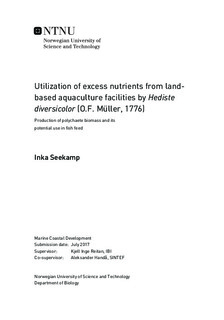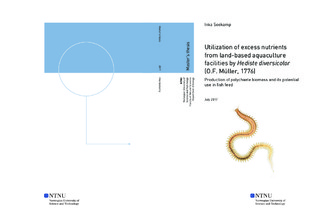| dc.description.abstract | Farming of Atlantic salmon (Salmo salar) is highly dependent on marine resources such as fish meal and fish oil. In Norway, supply of high quality raw materials and control of waste discharges from aquaculture are factors potentially limiting industry growth. A strategy to increase resource efficiency in salmon aquaculture is utilizing nutrient-rich waste streams for production of additional biomass in integrated multi-trophic aquaculture (IMTA) systems. This biomass constitutes a marine resource that could in turn be used in fish feed.
The objective of this thesis was to assess the potential of using Hediste diversicolor for recycling of nutrients contained in wastes from land-based aquaculture facilities. Moreover, the suitability of H. diversicolor, fed with these wastes, as a feed resource for carnivorous species was evaluated. A series of cultivation experiments using wild-caught polychaetes were performed in the laboratory to determine the impact of different diets on growth, mortality and biochemical composition of H. diversicolor. The results indicated that the species can successfully be cultivated on waste sludge as a sole feed source even though elevated ammonia levels restricted survival. Feeding of various, iso-carbonic diets resulted in different specific growth rates; fish feed constituted a more energy-dense diet than waste sludge and microalgae and thus lead to significantly higher growth. Different cultivation substrates had limited effect on growth and mortality, and mortality was not affected by different feed sources. Further, the biochemical composition of supplied diets did not significantly impact polychaete composition. Conclusively, it was shown that H. diversicolor can effectively utilize and incorporate nutrients contained in wastes from land-based aquaculture and subsequently function as a dietary resource for fish feed as it is high in protein and moreover contains for fish essential fatty acids and amino acids.
Keywords: Hediste diversicolor, polychaete, nutrient recycling, IMTA | |

